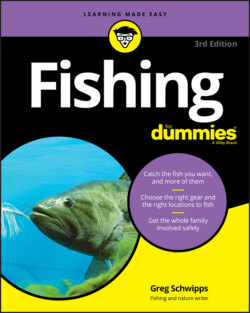Читать книгу Fishing For Dummies - Greg Schwipps - Страница 51
Knowing Where to Go
ОглавлениеAs Chapters 4 and 5 make clear, there are hundreds of species of fish awaiting you. While they prefer a variety of habitats, some of those fish may live close to you. Although no two waters are exactly alike (and that’s part of the fun of this whole adventure!), streams in the Midwest share some things in common with streams in the east or anywhere. Farm ponds are alike wherever you go. What you learn in one spot will add to your understanding of how to fish the next.
Fishable water is where you find it. Train yourself to look for water with the following two characteristics:
Access: Fishable water is either open to the public or privately owned. Public water is governed by rules, and your first step is to investigate and learn those rules. Is fishing allowed only during certain hours? Are there rules in addition to state laws that regulate the fishing? If the body of water is open to the public, these rules should be posted or otherwise available (often on a state’s Fish and Wildlife or Department of Natural Resources website). (See the section on fishing licenses in Chapter 2.)If the water is privately owned, then you must ask that owner’s permission. Never fish first, intending to ask later! It’s not only rude, but illegal. However, many landowners will grant you permission if you ask politely. Common-sense rules apply: Ask in a courteous manner; take rejection if it comes; be honest about your intentions (whether you intend to keep or release, for example); and don’t bring all your friends. In other words, it’s a lot like asking a father for permission to date his daughter. If you’re fishing in a farm pond, remember to shut all gates behind you — you don’t want to let any animals out!
Fish: Sometimes giant bodies of water hold only stunted populations of scrawny fish. Occasionally the little pond on the golf course yields a ten-pound largemouth. The only real way to know is to study the water. Private landowners often know what fish have been stocked in that body of water. Some public places will post notices about the fish available too.When it comes to finding good water close to home, there are two good sources to check out online before you leave the house. The first should be your state’s Department of Natural Resources (DNR) website. Another good source is the takemefishing.org website, which is a national, non-profit creation of the Recreational Boating and Fishing Foundation. Both will most likely list popular fishing areas as well as the fish you can expect to find there. Ideally, you should seek water that carries a healthy supply of your favorite kind of fish in an aesthetically pleasing environment. How do you find such a paradise? This chapter helps you locate it.
